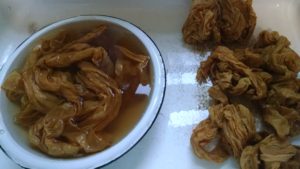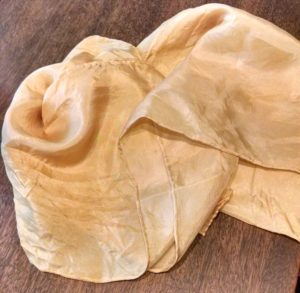When I recently had a need for yellow scarves, my thoughts went to dyeing my own – another interest of mine.
I immediately contacted a friend with whom I’ve shared many a dye bath, inquiring as to the whether she had any goldenrod – my first choice for good yellows. She didn’t but offered peach leaves…. Hmm…
I went cruising through my freezer, looking through my stashed dye-stuffs and lo and behold, I found a bag of goldenrod from a few years ago. (Doesn’t everyone have a bag of goldenrod in their freezer?)
While I awaited silk scarves to arrive from Dharma Trading Company (8”x72” silk scarves sell for about $3.50 each there), I started the dye bath. Taking the dark vegetable matter from the bag, I put it in a small pot of water and brought to a boil. (I always keep my dye pots separate from any other pots and identify them with string wound around the handles.) Then let it cool and set the pot aside.
When the scarves arrived, I washed them in dishwashing liquid, rinsed thoroughly and then put into an alum mordanting bath (alum – from the spice rack at the grocery store – about a couple tablespoons full for 10 light weight scarves). I swished them about, making sure they were well wetted, then let it sit for a couple of hours. Then I removed the scarves and hung them to dry.
Meanwhile, the dyebath was brought back to boiling for about an hour. Then I turned off the fire and put in the scarves. I left them 24 hours. The picture shows what they looked like when removed from the dyebath. A deep golden.
Then I rinsed them thorough, then washed in mild laundry detergent, rinsed again and they hung to dry.
Not bad! A pale golden yellow. Not the bright yellow I wanted, but beautiful none-the-less. That’s the way of natural dyeing. Experimentation.
May try those peach leaves – mixed with yellow onion skins? – for the next batch. Or … turmeric! That’s what colors mustard sauce yellow. I saw some turmeric root at the grocery store – think I’ll get some and experiment.



